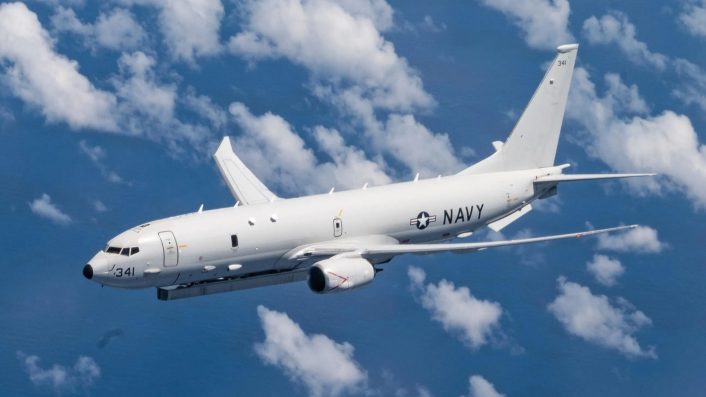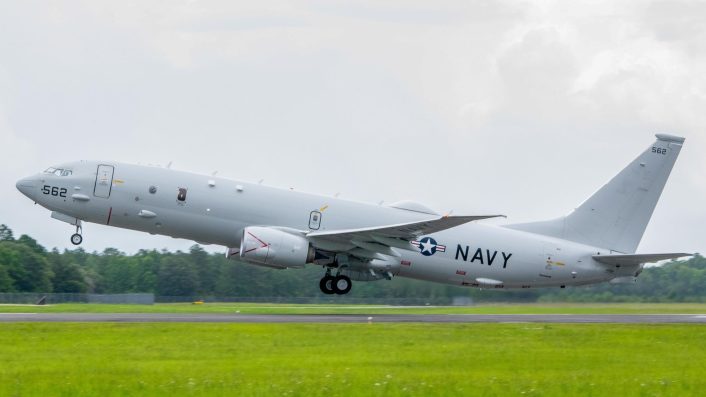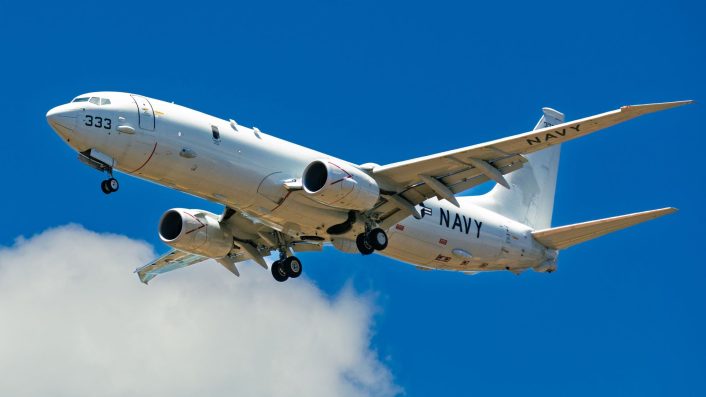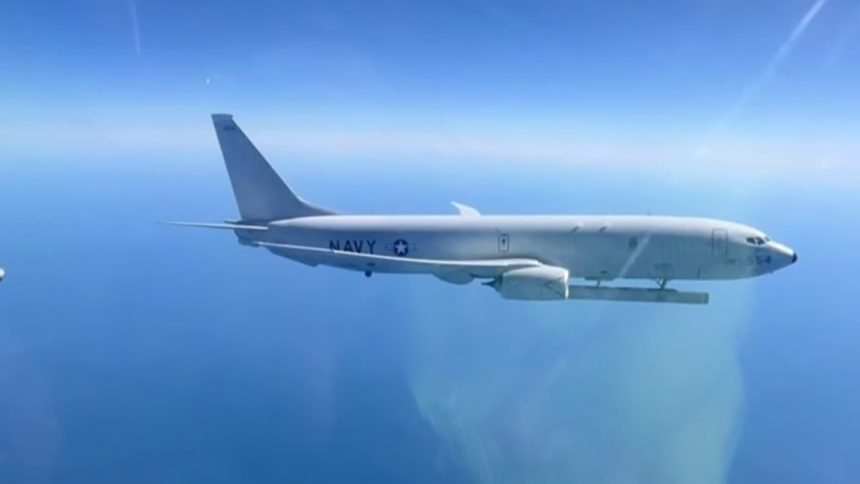A U.S. Navy P-8 Poseidon was intercepted over the Black Sea, with a video recorded by a Russian pilot showing the APS-154 Advanced Airborne Sensor extended below the fuselage.
A video recorded by a Russian pilot provides for the first time a good look at the P-8 Poseidon’s AN/APS-154 Advanced Airborne Sensor (AAS) extended during an operational flight. The video was published by the notorious Russian Telegram channel Fighterbomber, claiming it was recorded on Aug. 27, 2025.
The U.S. Navy Poseidon was reportedly intercepted by a Russian fighter over the Black Sea. Fighterbomber’s claim might not be unsubstantiated, as a P-8 indeed operated over the Black Sea today, as shown by data collected through multilateration (MLAT) on flight tracking websites.
The meeting between a Russian Sukhoi fighter jet and U.S. Navy Boeing P-8A Poseidon maritime patrol aircraft/ASW plane over the Black Sea. Video reportedly from today.
The P-8A is equipped with the AN/APS-154 Advanced Airborne Sensor multifunctional AESA radar, deployed under… pic.twitter.com/F6xo80Hyq4
— Status-6 (Military & Conflict News) (@Archer83Able) August 27, 2025
According to the available data, the multimission maritime aircraft (MMA) operated for four hours over the Black Sea on a track which followed the joining line between Varna, in Bulgaria, and Sochi, in Russia, stopping more than 50 nautical miles outside of Russian airspace. The flight originated and returned to Naval Air Station Sigonella, Italy, where the U.S. Navy routinely deploys its P-8s.
AE686F
US Navy P-8A Poseidon returning to Sigonella after a mission over the Black Sea. pic.twitter.com/LcQWO2Cy4F
— Pierre Davide Borrelli (@PierreDavideB) August 27, 2025
It is unclear where the Poseidon was intercepted, but it is safe to assume it happened south of Crimea, where most Russian intercepts take place. As for the aircraft, it was possibly a Black Sea Fleet Naval Aviation Su-30 Flanker based in Crimea, the same type usually employed to intercept intelligence aircraft over the Black Sea.
Plane registration pic.twitter.com/E2zRTGOl7e
— 𝗦𝗥_𝗣𝗹𝗮𝗻𝗲𝘀𝗽𝗼𝘁𝘁𝗲𝗿 (@SR_Planespotter) August 24, 2025
The aircraft sports the Modex 554 and is assigned to Patrol Squadron (VP) 5. VP-5 is currently deployed to the U.S. 6th Fleet area of operation at NAS Sigonella, according to recent U.S. Navy photos, as P-8 aircraft have been spotted on flight tracking websites in the previous days over the Black Sea on a similar route.
PAPA SIERRA 279 (VP-5 P-8A) & RAKE 20 (KC-135) wkg BUCHAREST RADAR for aerial refueling. PS279 was later intercepted over the Black Sea by a Ru Navy Su-30 fighter.
Notice this P-8 has its radar canoe extended.
Audio via @liveatc tracking via @flightradar24 🎥 Fighterbomber TG. pic.twitter.com/empzGi18Ee
— Thenewarea51 (@thenewarea51) August 28, 2025
AN/APS-154 Advanced Airborne Sensor
The AN/APS-154 Advanced Airborne Sensor (AAS) is one of the most significant upgrades for the U.S. Navy’s P-8A Poseidon fleet, designed to greatly expand the aircraft’s ability to conduct intelligence, surveillance and reconnaissance (ISR) missions in both maritime and littoral environments. Developed by Raytheon, the radar is the successor to the earlier AN/APS-149 Littoral Surveillance Radar System (LSRS), which was previously carried by a small number of modified P-3C Orions.
The AAS is a large, canoe-shaped pod mounted under the P-8A’s fuselage. Inside, it houses an active electronically scanned array (AESA) radar that provides a wide range of advanced surveillance modes.
These include synthetic aperture radar (SAR) imaging, which delivers detailed ground and maritime imagery in all weather conditions, and ground moving target indication (GMTI), which can detect and track moving vehicles over land. On the maritime side, the sensor offers maritime moving target indication (MMTI), specifically designed to identify and follow small, fast-moving surface contacts such as speedboats – a growing concern in congested littoral waters.

Beyond surface surveillance, the system is believed to have a classified set of electronic intelligence functions that contribute to the Poseidon’s broader ISR mission set. By feeding its data directly into the P-8A’s mission systems, the AAS plays a key role in the Navy’s network-centric operations, allowing collected information to be rapidly shared across joint and allied forces.
The AAS entered flight testing on the Poseidon in 2015, though, as with its predecessor, much of the program remains classified. What is clear, however, is that the sensor provides the P-8A with a capability set that goes well beyond the traditional anti-submarine warfare role of maritime patrol aircraft. In addition to supporting ASW and anti-surface warfare missions, it gives the Poseidon a valuable land surveillance function, making it a versatile platform for modern multi-domain operations.
P-8 Poseidon
The P-8A Poseidon is a long-range, multi-mission maritime patrol aircraft developed by Boeing for the U.S. Navy to replace the aging P-3C Orion. Based on the 737-800ERX airframe, the aircraft incorporates numerous structural and systems modifications to meet the demanding requirements of anti-submarine warfare (ASW), anti-surface warfare (ASuW), intelligence, surveillance and reconnaissance (ISR), and search and rescue (SAR) operations.

Internally, the Poseidon is equipped with an advanced mission suite that integrates multi-mode radar, an electro-optical/infrared (EO/IR) turret, and a comprehensive acoustic system capable of processing data from over 100 sonobuoys. The aircraft is also capable of deploying Mk 54 lightweight torpedoes, depth charges, and AGM-84 Harpoon anti-ship missiles from both its internal bomb bay and underwing hardpoints.
The P-8A is currently undergoing a significant capability enhancement with the Increment 3 Block 2 (I3B2) upgrade. First flown in June 2025, the Block 2 configuration introduces improved multi-static acoustic processing, new mission systems, an upgraded EW suite, and the integration of advanced weapons such as the AGM-158C Long Range Anti-Ship Missile (LRASM). The update also includes provisions for additional ISR and electronic support payloads, increasing mission flexibility.
Among the key enhancements is the High Altitude Anti-Submarine Warfare Capability (HAAWC), which enables the Poseidon to release torpedoes from high altitude using a winged glide kit. This development significantly increases survivability by allowing the aircraft to remain outside the threat envelope of submarine-launched or ship-based air defenses.

To improve survivability in contested environments, the U.S. Navy has also contracted BAE Systems to develop the Advanced Survivability Pod (ASP). The pod integrates radio-frequency and infrared threat detection, countermeasures, and a fiber-optic towed decoy system, providing protection against radar-guided and heat-seeking missiles.
In service with the U.S. Navy since 2013, the P-8A Poseidon is now also operated by several allied nations including Australia, the United Kingdom, Norway, India, and Germany. As maritime competition intensifies globally, the P-8A’s multi-mission capabilities, ongoing upgrades, and interoperability make it a cornerstone of modern naval operations.









